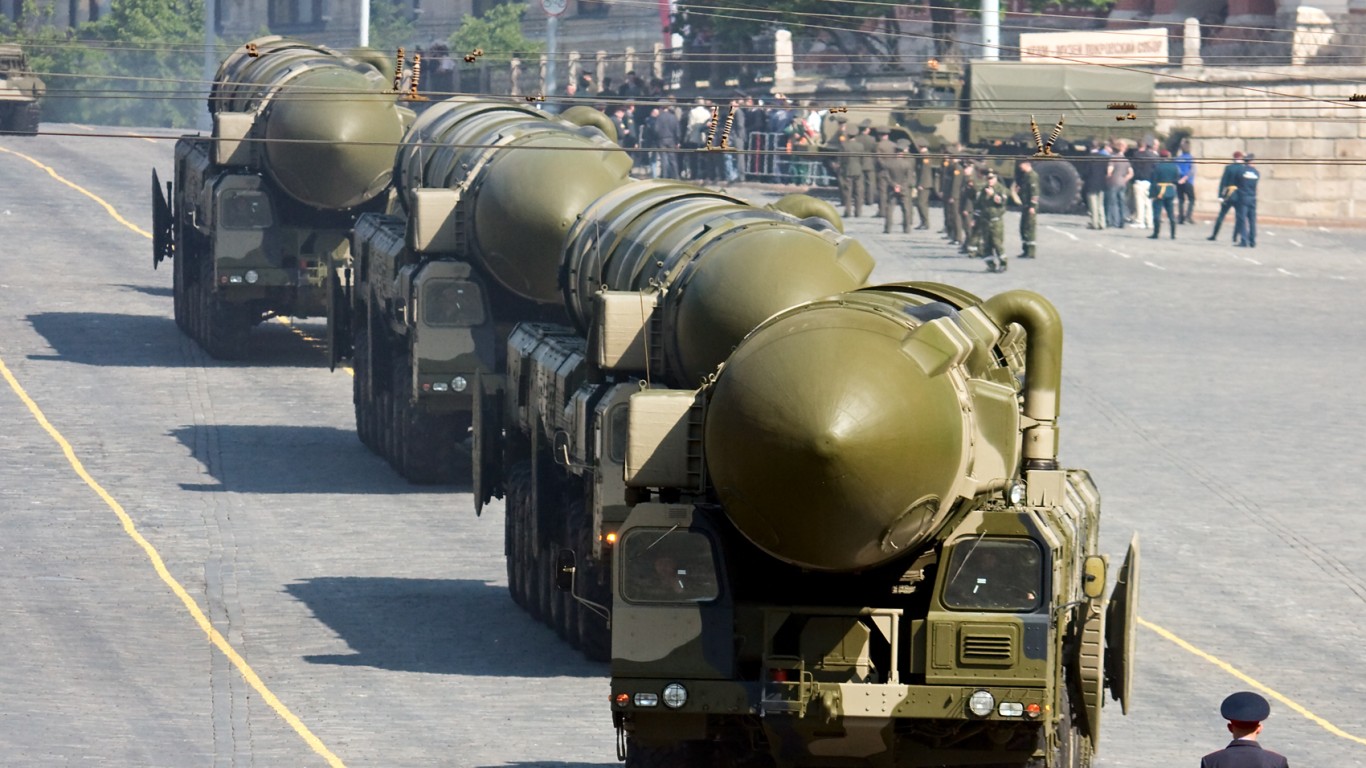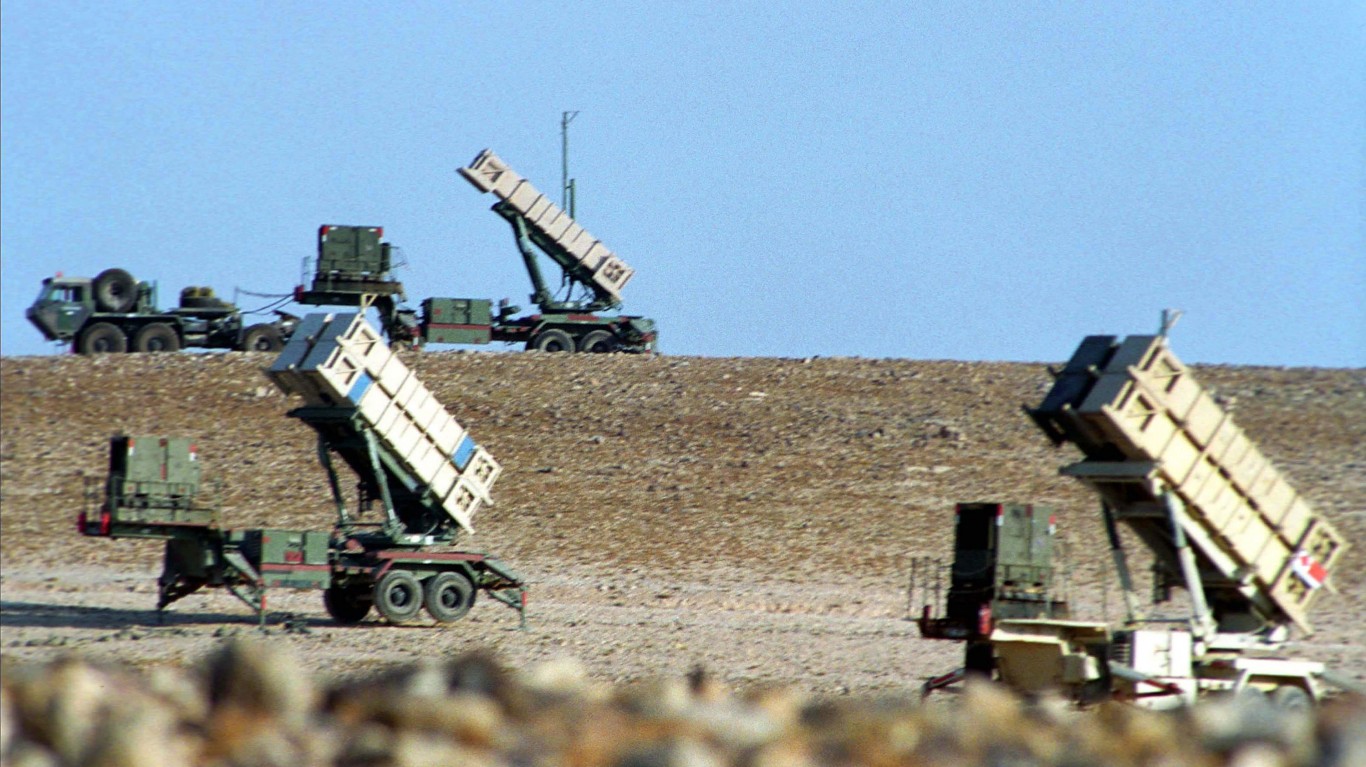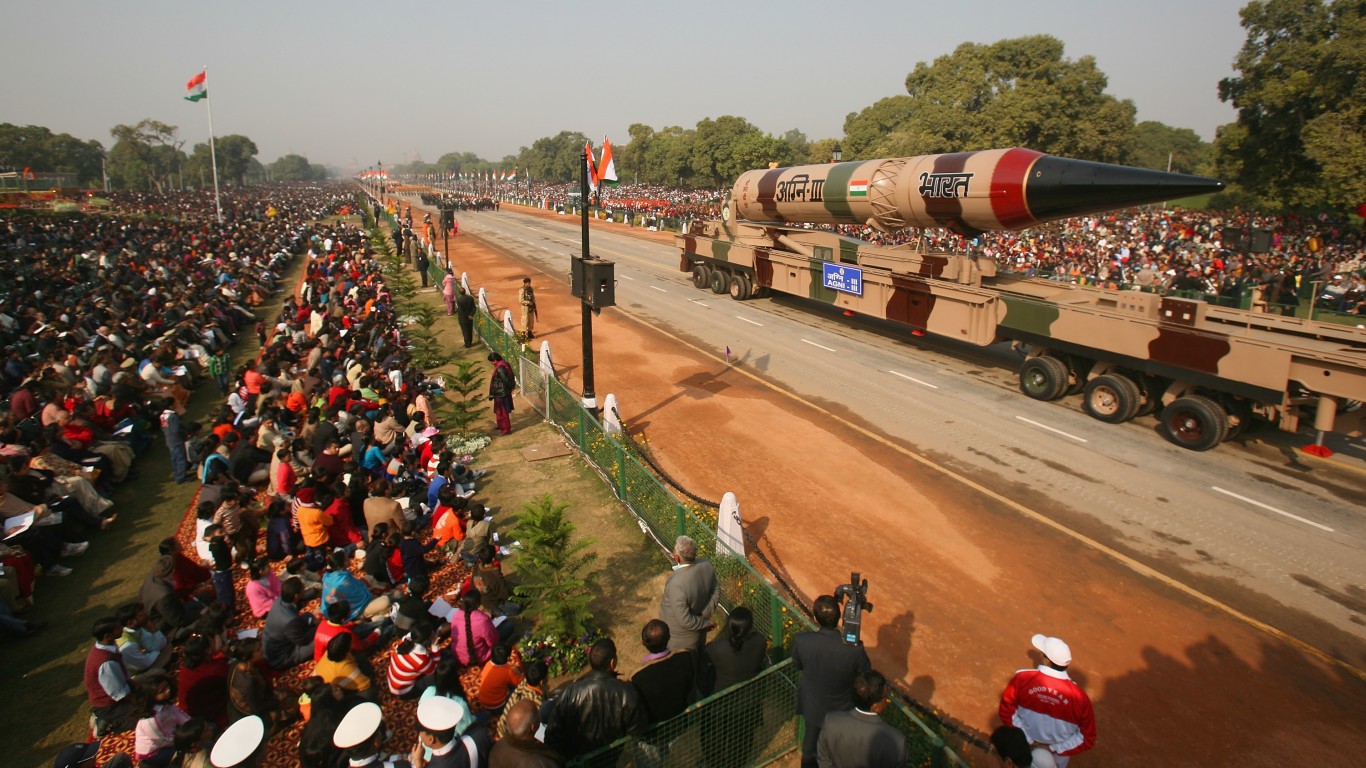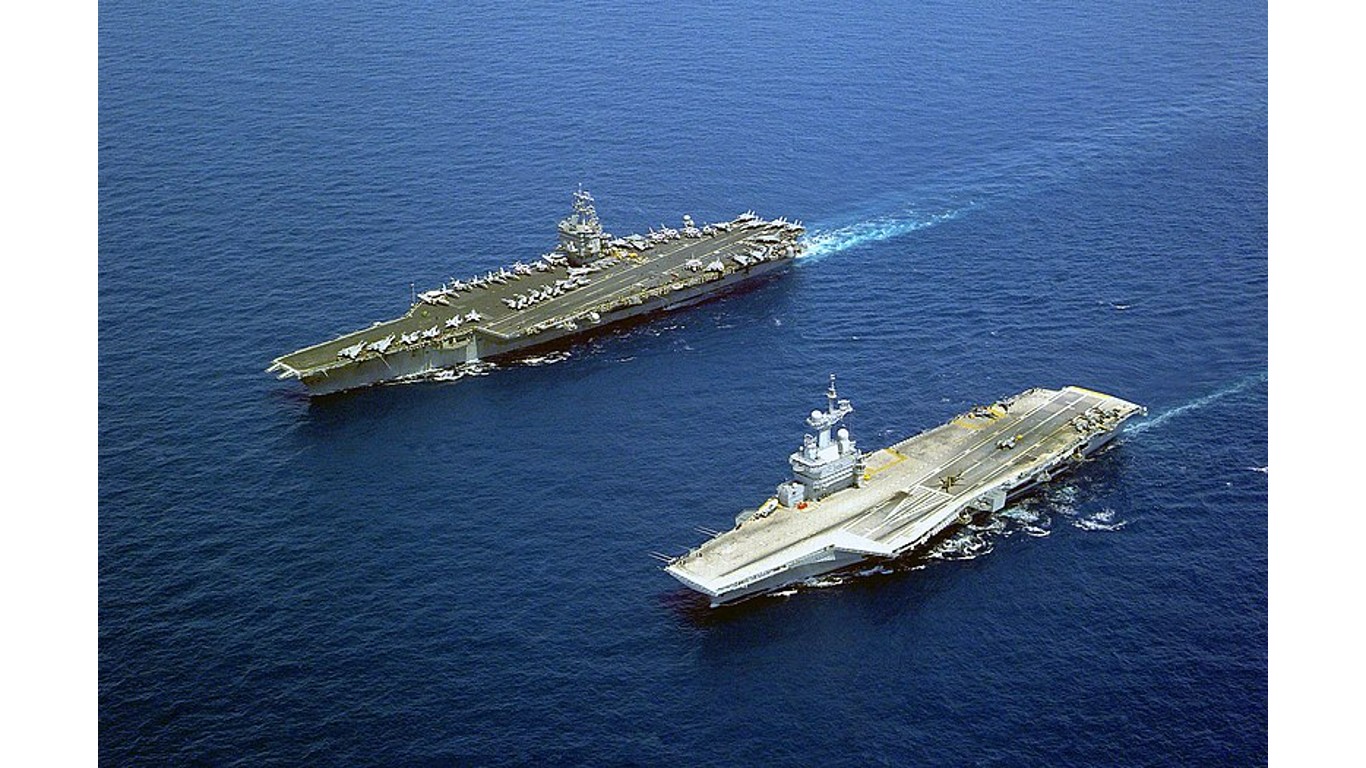
As the Russian invasion of Ukraine continues, one concern has been the use of tactical nuclear weapons. Recent reports indicate that Russia has been moving nuclear weapons into Belarus, a move that could turn a regional conflict into a potential World War III. (This is what a nuclear war would do to the world.)
Only two atomic bombs have ever been used in warfare, but their devastating consequences still reverberate to this day. The atomic bombings of Hiroshima and Nagasaki in Japan, while helping to end World War II, ushered in a new reality. Since then, other countries have successfully initiated nuclear weapons programs, and today there are over 12,500 nuclear warheads worldwide. Treaties about testing, non-proliferation, and later reduction helped limit the use and number of nuclear powers.
To determine the countries with nuclear weapons, 24/7 Wall St. reviewed Status of World Nuclear Forces from the Federation of American Scientists, an organization that works to reduce the spread of nuclear weapons and increase government transparency. The FAS breaks down a country’s nuclear weapons into four categories: retired, reserve/nondeployed, deployed nonstrategic, and deployed strategic. We combined the deployed warhead categories, while the reserve/nondeployed category is listed as “stored.” Military expenditure data came from The Stockholm International Peace Research Institute.
Although few countries around the world possess nuclear weapons, those that do tend to have stronger militaries altogether and higher rates of military spending. In fact, GlobalFirepower ranks many of the countries on this list as having some of the strongest conventional militaries on the planet.
The two top names on this list, the United States and Russia (considered successor of the Soviet Union) share a lengthy history of nuclear rivalry, stemming from years of Cold War tensions. The two superpowers possess the largest stockpiles, with approximately 5,244 and 5,889 nuclear warheads, respectively – or about 89% of all the nuclear weapons in the world. (Here is what a nuclear attack would do to America’s 25 largest cities.)
Close allies of the United States, the United Kingdom and France, also maintain considerable nuclear arsenals. They have approximately 225 and 290 warheads, respectively.
China, a rising global power, has rapidly expanded its nuclear capabilities in recent years. The nation currently holds an estimated 410 nuclear warheads, highlighting its growing geopolitical ambitions and strategic concern over the nuclear balance in Asia.
India and Pakistan, both nuclear-armed South Asian neighbors, have engaged in multiple conflicts since achieving independence. Their mutual mistrust has led them to build nuclear arsenals in an effort to maintain a balance of power in the region, with both adopting the doctrine of “no first use.” India has around 160 nuclear warheads and Pakistan around 170.
Many international groups, including the United Nations, have been pushing for long-term international disarming agreements. However, with growing geopolitical tensions, such agreements may fail to gain traction.
Click here to see the country with the most nuclear weapons.
9. North Korea
> Total nuclear warheads: 30
> Number of deployed nuclear warheads: 0
> Number of stored warheads: 30
> Year of first test: 2006
> Military expenditure (2022): N/A
Ever fearful of foreign intervention, leaders of the Hermit Kingdom have aggressively pursued the development of nuclear weapons systems to serve as a deterrent. North Korea maintains a “no-first-use” policy since its fourth nuclear weapons test in 2016, but the country’s strictly controlled media has made nuclear threats for perceived provocations, like U.S.-South Korean military exercises. FAS estimates that North Korea may have produced enough fissile material to build between 40 and 50 nuclear weapons, though it may not have assembled that many.
[in-text-ad]

8. Israel
> Total nuclear warheads: 90
> Number of deployed nuclear warheads: 0
> Number of stored warheads: 90
> Year of first test: 2008
> Military expenditure (2022): $23.4 billion
It is an open secret that Israel has nuclear weapons, but because the country does not acknowledge its possession of such weapons, it is very difficult to conduct research on Israel’s nuclear capabilities. Still, it is believed that Israel has air and land-based nuclear weapons delivery systems as well as a rumored sea-based land-attack cruise missiles. Israel’s primary security concern is that Iran could soon develop its own nuclear weapons.

7. India
> Total nuclear warheads: 164
> Number of deployed nuclear warheads: 0
> Number of stored warheads: 164
> Year of first test: 1974
> Military expenditure (2022): $81.4 billion
India and Pakistan have stockpiled plenty of nuclear arms to wipe each other out amid cold war-like tensions regarding the territorial dispute of the Kashmir region that both countries claim. India can launch nuclear weapons by air, land, and sea, and it is believed to be expanding its land-based ballistic missile stockpile. India is estimated to have produced enough military plutonium for 150 to 200 nuclear warheads but has likely produced only 150 to 160.

6. Pakistan
> Total nuclear warheads: 170
> Number of deployed nuclear warheads: 0
> Number of stored warheads: 170
> Year of first test: 1998
> Military expenditure (2022): $10.3 billion
Tensions between Pakistan and India make this one of the world’s most tense nuclear standoffs. Both countries are expanding their nuclear arsenals and delivery systems. U.S. intelligence may vastly underestimate how many nuclear weapons Pakistan would have developed by 2020. Like its adversary, India, Pakistan can launch nuclear warheads from air, land, and sea. FAS estimates that the country’s stockpile could grow to around 200 by 2025.
[in-text-ad-2]

5. United Kingdom
> Total nuclear warheads: 225
> Number of deployed nuclear warheads: 120
> Number of stored warheads: 105
> Year of first test: 1952
> Military expenditure (2022): $68.5 billion
The U.K. has the fifth-largest arsenal of nuclear weapons, with more than half available for quick deployment on four Vanguard-class nuclear-powered ballistic missile submarines. The U.K. is the only nuclear weapon country that has only one deterrence system. One Vanguard carrying about 40 warheads is deployed at sea at all times as an ongoing deterrent. In 2021, the U.K. government announced the country would increase its stockpile ceiling to up to 260 warheads.

4. France
> Total nuclear warheads: 290
> Number of deployed nuclear warheads: 280
> Number of stored warheads: 10
> Year of first test: 1960
> Military expenditure (2022): $53.6 billion
France has 65 more nuclear warheads than Britain, not counting about 10 warheads that are spares or in maintenance, making it the fourth-largest nuclear power. Unlike the United Kingdom, which maintains only a submarine-based force, France can launch 50 nuclear weapons from its Rafale fighter jets by land or aircraft carrier. The rest of its nuclear warheads are submarine based. France’s nuclear arsenal of nearly 300 warheads has remained stable in recent years, the FAS notes.
[in-text-ad]

3. China
> Total nuclear warheads: 410
> Number of deployed nuclear warheads: 0
> Number of stored warheads: 410
> Year of first test: 1964
> Military expenditure (2022): $292.0 billion
China is believed to have the world’s third-largest nuclear arsenal, but its estimated 410 weapons systems is a fraction of the nearly 12,000 nuclear weapons held by the U.S. and Russia. But like Russia, China is modernizing its nuclear weapons systems to keep up with its competitors, including construction of new intercontinental missiles and missile silos. China’s stockpile is expected to increase significantly in the next decade, the FAS estimates.

2. United States
> Total nuclear warheads: 5,244
> Number of deployed nuclear warheads: 1,770
> Number of stored warheads: 1,938
> Year of first test: 1945
> Military expenditure (2022): $876.9 billion
The United States is the oldest nuclear weapons country and the only one to have used nuclear bombs against another country. The oldest still active U.S. nuclear weapons stockpile was first deployed in 1961 and currently consists of 46 nuclear-capable B-52 bombers. The U.S. has deployed modern submarine-launched ballistic missiles since 2008. Of the near 1,800 deployed nuclear warheads, 400 are on land-based intercontinental ballistic missiles, roughly 1,000 are on submarine-launched ballistic missiles, 300 are at bomber bases in the U.S., and 100 tactical bombs are at European bases. The U.S. also retired 1,536 warheads.

1. Russia
> Total nuclear warheads: 5,889
> Number of deployed nuclear warheads: 1,674
> Number of stored warheads: 2,815
> Year of first test: 1949
> Military expenditure (2022): $86.4 billion
The Russian Federation is the largest nuclear power, with the largest arsenal of nuclear warheads. Russia is wrapping up a decades-long modernization of its nuclear arsenal, replacing Soviet-era weapons. In recent years, Russia deployed additional nuclear cruise missiles that can be fired from its Tupolev Tu-160 (aka Blackjack) strategic bombers. Of Russia’s 4,489 deployed and stored warheads, about 1,674 strategic warheads are deployed on ballistic missiles and at heavy bomber bases. Russia also retired 1,400 warheads, the FAS estimates.
It’s Your Money, Your Future—Own It (sponsor)
Are you ahead, or behind on retirement? For families with more than $500,000 saved for retirement, finding a financial advisor who puts your interest first can be the difference, and today it’s easier than ever. SmartAsset’s free tool matches you with up to three fiduciary financial advisors who serve your area in minutes. Each advisor has been carefully vetted and must act in your best interests. Start your search now.
If you’ve saved and built a substantial nest egg for you and your family, don’t delay; get started right here and help your retirement dreams become a retirement reality.
Thank you for reading! Have some feedback for us?
Contact the 24/7 Wall St. editorial team.

 24/7 Wall St.
24/7 Wall St.
